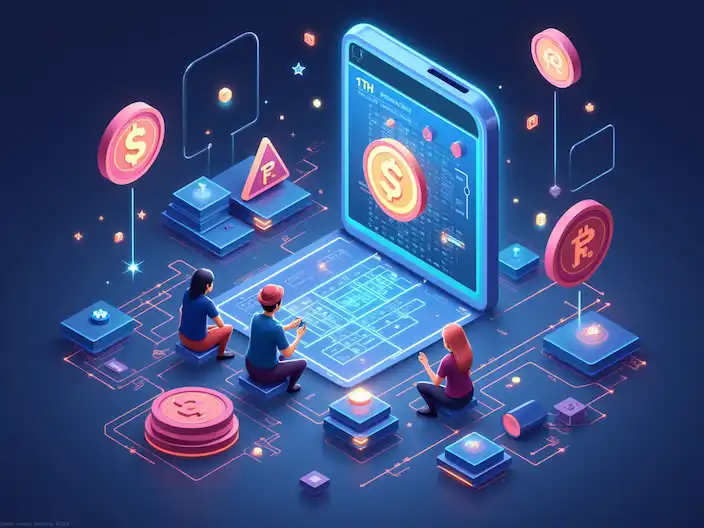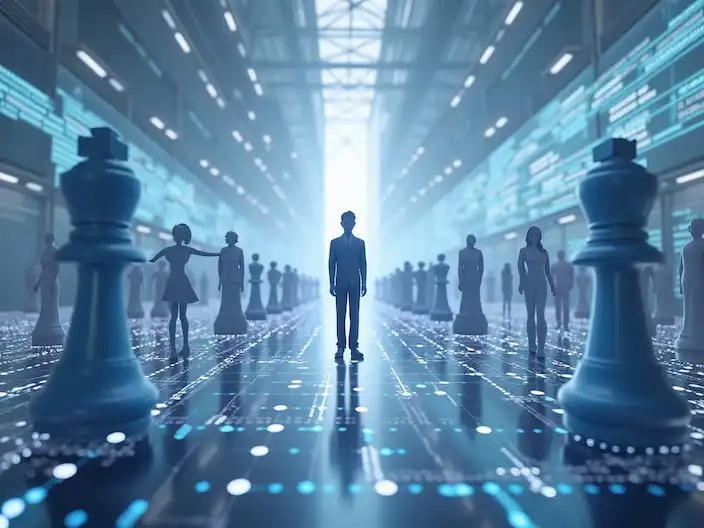1. Introduction
In the era of digital transformation, a new concept called the “Metaverse” is emerging — a hyperreal, interactive, and constantly expanding environment that blurs the boundaries between the physical and digital worlds. The Metaverse is not merely a space for gaming and entertainment; rather, it is forming as a new infrastructure for social, economic, educational, and even governance activities. In such a world, users are not just content consumers but active players within an interactive economic ecosystem. Therefore, understanding user behavior patterns and how they interact with one another has become a critical issue in the design of Metaverse economies.
One of the fundamental challenges in structuring the Metaverse economy is designing incentive and interaction systems capable of ensuring sustainable participation, innovation, fair resource distribution, and — most importantly — healthy competition among users. In this regard, Game Theory, as one of the most effective tools for analyzing strategic behavior in multi-agent and interactive conditions, has played an irreplaceable role in designing behavioral and economic mechanisms.
Game Theory makes it possible to examine user behavior through mathematical and logical models and predict the outcomes of collective decision-making in complex environments like the Metaverse. In fact, any transaction, interaction, or cooperation in the Metaverse can be considered a multiplayer game with specific rules, in which players (users, developers, investors, and governing institutions) seek to optimize their own interests within either competitive or collaborative frameworks.
On the other hand, the dynamic, simultaneous, and decentralized nature of the Metaverse means that static analyses and models no longer meet its needs. For this reason, the use of dynamic game models, where decision-making by players is examined over time, has gained increasing importance. These models not only provide a more accurate simulation of user behavior over time but are also compatible with machine learning systems and decision-support algorithms.
This article seeks to leverage Game Theory — particularly concepts like Nash equilibrium, dynamic games, and participation and reward mechanisms — to present a theoretical and practical framework for designing Metaverse economies based on purposeful interactions, behavioral dynamics, and ethical competition. To this end, it first reviews the fundamental concepts of Game Theory and its place in multi-agent digital environments. Then, by conducting a comparative analysis of findings from two key articles on dynamic environmental economics and Metaverse economies, it proposes practical mechanisms for applying Game Theory to regulate economic relations within the Metaverse.
This research, with an analytical and forward-looking approach, aims to take a step toward theorizing and operationalizing the concepts of interaction, convergence, healthy competition, and economic sustainability in the Metaverse — a world where the economy is no longer a secondary layer but a vital core of the entire user experience.

2. Fundamental Concepts of Game Theory
Game Theory is a branch of applied mathematics and economics that examines decision-making in situations of conflict, competition, and cooperation among rational actors. In this framework, a “game” is not defined as entertainment but as a scenario involving a set of actors (players), possible strategies, and specific outcomes. Game Theory was transformed in the 20th century, especially through the works of John von Neumann and John Nash, and has become an essential tool for analyzing social, economic, political, and — more recently — technological interactions.
2.1. Basic Structure of a Game
Every game in Game Theory consists of the following elements:
- Players: Decision-makers who can be humans, organizations, robots, or even software agents within the Metaverse.
- Strategies: The set of possible actions each player can choose from.
- Payoff Function: A function that assigns a numerical or qualitative outcome to each combination of strategies, representing the profit or loss of each player.
- Information: The level of awareness players have regarding the game’s state, other players’ moves, and outcomes. Based on this, games are categorized into complete-information and incomplete-information types.
2.2. Types of Games Based on Time and Structure
- Static Games: Players make decisions simultaneously without knowledge of others’ choices. Example: simultaneous auctions.
- Dynamic Games: Decision-making occurs over time, with players able to observe and respond to others’ actions. This type is especially applicable for modeling in the Metaverse.
- Zero-Sum and Non-Zero-Sum Games: In zero-sum games, one player’s gain is exactly equal to another’s loss (as in purely competitive games). In contrast, non-zero-sum games can result in win-win or win-lose outcomes, which are essential for designing positive, collaborative incentives within the Metaverse.
2.3. Nash Equilibrium
One of the key concepts in Game Theory is the Nash Equilibrium. This equilibrium occurs when no player, assuming others’ strategies remain constant, has an incentive to change their own strategy. In the Metaverse, Nash equilibrium can represent a stable state of interaction among users, developers, economic institutions, and intelligent algorithms, where none can increase their benefit without altering the entire incentive structure.
2.4. Repeated Games and Reinforcement Learning
Another practical feature of Game Theory for the Metaverse is repeated games, where player interactions are not one-off but occur repeatedly over time. In this scenario, reputation, credibility, and past behaviors directly influence future strategies. Combining this model with reinforcement learning algorithms can lead to adaptive behaviors in intelligent agents within the Metaverse.
2.5. Mechanism Design and Its Application in the Metaverse Economy
One of the advanced areas of Game Theory is Mechanism Design, which is essentially the reverse of Game Theory. In this approach, the system designer — such as a Metaverse platform or DAO — instead of analyzing an existing game, attempts to design rules that lead to desired outcomes. This technique is particularly useful in designing reward systems, NFT distribution, resource management, smart contract regulation, and controlling opportunistic behaviors in the Metaverse.
2.6. Evolutionary Games and Collective Behavior Modeling
In complex environments like the Metaverse, where large numbers of users, agents, and institutions interact simultaneously, evolutionary games become increasingly important. In this framework, user behavior gradually changes in response to environmental and social pressures. Using evolution-inspired algorithms — such as genetic algorithms or replicator dynamics — makes it possible to analyze the dynamics and long-term stability of strategies.
2.7. Applications of Game Theory in the Metaverse World
In the Metaverse environment, Game Theory can be used for analysis and design in areas such as:
- Managing token ecosystems and digital currencies.
- Designing collaborative structures in decentralized organizations (DAOs).
- Defining incentive structures for content creation, user presence, and participation.
- Managing unhealthy behaviors like spam, fraud, and digital hoarding.
- Regulating competition among virtual businesses within Metaverse markets.

3. Metaverse Economy: From Concepts to Reality
The metaverse economy is one of the most dynamic and complex emerging fields at the intersection of technology, sociology, blockchain, and game theory. Unlike traditional economies, which are based on physical resources, tangible markets, and geographical borders, the metaverse economy is founded upon data, digital interaction, intangible assets, and decentralized institutions. This economy presents new opportunities for value creation, production, exchange, and ownership of digital assets, opening an entirely new horizon for economic structures.
3.1. Definition of the Metaverse Economy
The Metaverse Economy refers to a system of production, distribution, consumption, and ownership relationships within an immersive virtual environment, built on technologies such as blockchain, smart contracts, virtual reality (VR), augmented reality (AR), and the Internet of Things (IoT). This economy, through the interaction of users, developers, companies, decentralized autonomous organizations (DAOs), and even AI agents, constitutes a self-sustaining and evolving ecosystem.
3.2. Core Pillars of the Metaverse Economy
The metaverse economy can be structured around four primary pillars:
- Digital Ownership: NFT (Non-Fungible Token) technology enables possession of virtual assets such as digital lands, artworks, avatar wearables, and other virtual items.
- Value Exchange and Revenue Generation: Users can earn income through participation in Play-to-Earn games, offering services, selling works, renting virtual spaces, or even actively engaging in communities.
- Decentralized Governance Institutions: Structures like DAOs allow users to participate in macro-level decision-making processes and in setting the economic rules of the game.
- Tokenomics: The design and balance of supply, demand, incentives, and rewards through native tokens form the backbone of a sustainable economic operation within the metaverse.
3.3. Typology of Metaverse Markets
Various types of markets have emerged within the metaverse, each with its own characteristics and behaviors:
- NFT Markets: Platforms for trading unique assets, ranging from digital art to virtual land.
- Digital Service Markets: Where users and avatars can offer services like avatar design, programming, consulting, or even education.
- Metaverse Labor Markets: From digital freelancers to platform workers in virtual worlds, new forms of work and productivity have developed.
- Data and AI Markets: Users’ behavioral data is treated as an economic commodity, sold to platforms and businesses for optimizing user experiences.
3.4. Challenges and Threats in the Metaverse Economy
Despite its high potential for growth and transforming economic systems, the metaverse economy faces fundamental challenges that require analysis:
- Legal Uncertainties: Legal gaps concerning ownership, taxation, inheritance, and copyright within virtual spaces.
- Hidden Centralization: Although the metaverse is designed around decentralization, in practice, some platforms hold disproportionate power.
- Information Pollution and Data Exploitation: Excessive user data collection and its sale without informed consent can result in a form of modern digital exploitation.
- Speculative Behavior and Economic Bubbles: Many metaverse projects are driven by unrealistic expectations and speculation, which may lead to user losses.
3.5. Foresight on the Metaverse Economy
The metaverse economy is evolving toward a more mature phase where integrating intelligent technologies with behavioral economics and game theory transforms platforms into self-regulating, sustainable systems. Key trends along this path include:
- Employing multilayer smart contracts to manage markets.
- Creating incentive structures based on game theory to balance competition and collaboration.
- Developing economic education systems within the metaverse to empower users.
- Transforming business models based on avatar and AI interactions.
3.6. The Role of Game Theory in Shaping the Metaverse Economy
Game theory plays a foundational role in analyzing and designing metaverse economic structures. From NFT market design to managing relationships between DAOs, from modeling competition between platforms to organizing collaboration networks — all require a precise understanding of strategic interactions among actors. The next section of this article will extensively analyze how to integrate this theory with the economic requirements of the metaverse.

4. Fair Competition in the Metaverse Economy
Fair competition in the metaverse economy is a strategic, multidimensional, and transformative concept closely tied to principles of justice, equal opportunity, information transparency, and incentive systems based on fair rewards. Unlike classic competition in traditional economies — often characterized by monopolistic practices, market manipulation, and exhausting rivalries — the metaverse has the capacity to offer a new model of creative, cooperative, and synergistic competition. In this environment, users, as independent and intelligent actors, compete within dynamic, interactive platforms. This competition can become an engine for economic growth within virtual worlds, provided it’s built upon principles of game theory, algorithmic fairness, and structural transparency.
4.1. Defining Fair Competition in the Metaverse
Fair competition in the metaverse refers to the interaction process among users, platforms, developers, and decentralized institutions, where each actor, while respecting the rights of others, seeks to increase productivity, deliver better services, and create greater value within a shared ecosystem. In this form of competition, victory is not achieved through undermining others, but by enhancing one’s capabilities and fostering collective synergy.
4.2. Dimensions of Fair Competition
Fair competition within the metaverse economy encompasses several dimensions, each playing an independent role in the ecosystem’s sustainability and growth:
- Competition Among Users: Competing to earn income, improve social status, upgrade avatars, and seize economic opportunities in gamified environments.
- Competition Among Platforms: Companies and developers competing technologically and in design to attract users, improve user experiences, offer innovative services, and gain market trust.
- Competition Among DAOs and Decision-Making Bodies: In decentralized structures, competition manifests through policy proposals, voting processes, and optimizing digital governance mechanisms.
- Competition Among Digital Assets: Assets such as tokens, NFTs, virtual lands, and metaverse brands compete in valuation, liquidity, and market acceptance.
4.3. Tools for Ensuring Fair Competition in the Metaverse
To prevent competition in the metaverse from veering into unethical, destructive, or unbalanced territory, tools and mechanisms must be designed to safeguard ecosystem integrity. These include:
- Data and Algorithm Transparency: Publicizing information related to transactions, ranking criteria, and reward formulas to prevent unequal opportunities.
- Self-Executing Smart Contracts: Designing competitive processes in a way that human manipulation becomes impossible, ensuring equal opportunities for all.
- Restricting Monopolies and Unfair Disincentives: Tokenomic systems must be designed so rewards correlate with effort and creativity while preventing wealth accumulation in the hands of a minority.
- Behavioral Rules and Digital Rights for Users: Establishing behavioral guidelines and decentralized community governance to minimize exploitation of competitive situations.
4.4. The Application of Game Theory in Ensuring Fair Competition
Game theory is a powerful tool for simulating interactions between metaverse users and designing structures in which competition moves toward Nash Equilibrium and collective optimal outcomes (Pareto Efficiency). Some of its key functions in this regard include:
- Modeling co-opetition games: where users simultaneously compete and cooperate.
- Designing incentive mechanisms: such as repeated games, to strengthen trust and reduce tendencies toward betrayal or toxic behavior.
- Analyzing multiple equilibria: to identify strategies yielding the highest returns for the ecosystem and rewarding sustainable behaviors.
4.5. Examples of Fair Competition Implementation in Metaverse Platforms
- Axie Infinity: a reward system for players demonstrating constructive engagement with the environment, based on participation frequency and rule adherence.
- The Sandbox: creating equal opportunities for content creators through a free market, smart contracts, and community oversight of assets.
- Decentraland: allocating public spaces for non-profit activities and balancing economic and cultural opportunities.
4.6. Fair Competition as a Driver of Innovation
Fair competition not only supports the metaverse’s economic sustainability but also stimulates innovation, drives technological advancement, enhances user experience standards, diversifies services, and cultivates new markets. When users realize that growth is achievable through creativity, education, engagement, and digital skill development, a productive economic cycle will emerge—one that is both profitable and human-centered.

5. Proposed Game Theory Framework for the Metaverse
In the metaverse, where interactions are simultaneously synchronous, multilayered, and decentralized, designing a sustainable and efficient economic system requires an analytical, predictive model. As a branch of applied mathematics and behavioral economics, game theory serves as an appropriate tool for modeling decision-making in competitive and cooperative environments. However, given the complexity of metaverse structures and the presence of autonomous elements, a tailored framework for adapting game theory to virtual worlds is necessary.
5.1. The Need for a Game-Theoretic Framework for Metaverse Economies
Unlike traditional markets, the metaverse faces characteristics such as global real-time user interactions, digital asset-based economies, decentralized structures (DAOs), and rapid, transparent transactions. These require an analytical model capable of:
- Predicting the strategic behavior of millions of users
- Creating a stable balance between competition and cooperation
- Modeling user decision-making dynamics over time
- Being executable via intelligent algorithms and self-executing contracts
5.2. Proposed Structure for a Game-Theoretic Framework for the Metaverse
Based on a study of credible resources and analysis of scientific documentation, the following framework is proposed for integrating game theory into metaverse economy design:
5.2.1. Layer One: Basic Strategic Game Modeling
- Game Type: Non-Cooperative games with Incomplete Information
- Actors: Users, developers, DAOs, investors, brands
- Strategies: Buying/selling NFTs, participating in voting, content creation, mining or staking
- Objective: Identify Nash Equilibrium points and assess their stability
5.2.2. Layer Two: Repeated Games with Historical Memory
- Mechanism: Designing infinitely repeated games where a player’s past behavior impacts future rewards
- Application: Preventing destructive actions, encouraging long-term interaction, and building trust
- Tools: Configurable smart contracts, reputation score algorithms, time-series analysis of interactions
5.2.3. Layer Three: Multi-Agent Games with Adaptive Learning
- Model: Utilizing Agent-Based Modeling (ABM) and Reinforcement Learning to analyze player behavior
- Application: Predicting user reactions to new economic policies or market changes
- Feature: Compatible with dynamic, self-organizing metaverse environments
5.2.4. Layer Four: Co-opetition Games (Collaborative-Competitive)
- Model: Combining collective and individual interests; users simultaneously cooperate and compete to achieve shared goals
- Example: Competing in the creation of a virtual world with limited resources, where better cooperation generates higher rewards
- Tools: Group incentives, collaborative rewards, governance layers
5.2.5. Layer Five: Reward and Cost Design Based on Game Theory
- Economic Design Role: Regulating rewards, taxes, opportunity costs, and inflation based on strategic behavior predictions
- Pattern: Setting token distribution or mining rates according to user behavior and market conditions
- Outcome: Establishing balance between supply and demand, preventing economic bubbles, and promoting long-term incentives
5.3. Advantages of the Proposed Framework
| Indicator | Advantage |
| 🎯 Analytical Accuracy | Accurate prediction of user behavior through precise strategy modeling |
| 🔁 Dynamism | Adaptability to market changes and the entry of new users |
| ⚖️ Structural Justice | Designing fair policies for all users |
| 📡 Automation | Implementable through automated algorithms and blockchain |
| 🚀 Innovation Capability | Potential to develop local, cultural, and decentralized economies |
5.4. Implementation Steps for Framework Deployment
- Define the ecosystem of actors and their roles
- Categorize competitive, cooperative, and hybrid interactions
- Design reward and penalty algorithms through repeated games
- Configure smart contracts based on game equilibria
- Simulate and analyze user behavior in various scenarios

6. Conclusion and Recommendations
6.1. Overall Summary
In an era where the boundary between reality and virtuality is collapsing through technologies like the metaverse, the need to redefine economic concepts, interaction models, and incentive structures is increasingly felt. This article, focusing on game theory as one of the fundamental tools for analyzing decision-making in competitive and collaborative environments, sought to propose a scientific, practical, and metaverse-compatible framework for designing digital economies based on fair competition and dynamic interaction.
Foundational concepts such as Nash Equilibrium, repeated games, strategic behavior, and multi-agent modeling play a pivotal role in this framework, enabling not only the prediction and guidance of user behavior but also laying the groundwork for new economic structures that prioritize social balance, sustainability, and collective value creation over short-term individual gain.
Moreover, analysis of the metaverse economy revealed that due to its unique features—digital assets, decentralized structures, real-time multi-layered communications—a distinct economic model is required, one that simultaneously orchestrates interaction, competition, cooperation, motivation, and compensation aligned with platform and user objectives.
6.2. Strategic Recommendations for Developing a Game-Theoretic Metaverse Economy
- Draft a gamified roadmap for metaverse digital economy design
It’s recommended that organizations, platforms, and developers adopt game theory models to design rewards, set participation policies, analyze user behavior, and predict changes. This can be achieved through collaborations with universities and research teams in behavioral economics and multi-agent modeling. - Create a scenario bank for analyzing user conflict and cooperation
Developing a collection of interactive scenarios based on classical games (like the Prisoner’s Dilemma, Dictator, Stag Hunt, etc.) will help developers analyze user behavior in realistic conditions and formulate more effective economic and managerial policies. - Use machine learning algorithms to analyze repeated games
By leveraging artificial intelligence technologies—particularly reinforcement learning—user behavior patterns in repeated games can be analyzed, enabling the development of models that simultaneously increase motivation, reduce behavioral risks, and improve user retention rates.
- Designing Arbitration and Balancing Platforms Based on Collective Intelligence
o Utilizing voting mechanisms grounded in game theory (such as Reynolds voting, social choice theory, and Nash-Bargaining models) can be effective in determining economic policies, resolving conflicts, and managing digital ownership in the metaverse. - Emphasizing Economic Ethics and Justice in Game Design
o Although game theory is inherently neutral, the design of metaverse economies must also consider ethical aspects, distributive justice, information transparency, and the prevention of unilateral dominance. This is especially important in dealing with DAOs, NFT economies, and Play-to-Earn games. - Developing Performance Monitoring Metrics Based on Gamified Behavior
o It is recommended to design and present indicators such as the Game-Based Engagement Score, Behavioral Consistency Index, and Cooperation Stability Rating in management dashboards to monitor user performance, validate participation, and analyze behavioral data.
6.3. Final Conclusion: Beyond Games, Towards a New Organization of Virtual Communities
The metaverse is not merely an entertainment or interaction platform; it holds the potential to become the primary hub for future economic, cultural, and social interactions. Applying game theory within this space not only creates efficiency and sustainability in the digital economy but also paves the way for building communities based on self-organization, trust, healthy competition, and continuous innovation.
This article aimed to propose an integrated model for designing a metaverse economy, drawing on the latest academic resources — a framework that can serve as a reference for researchers, digital market practitioners, technology policymakers, and virtual platform managers.
Table of Contents
Toggle

